Cozumel Whaleshark Season 2023
Whale Shark Season 2023: Tips for Having the Best Experience
Quintana Roo is lucky enough to be located on the migration route of the Whale Shark (Rhincodon typus). While Cozumel isn’t part of the migration route, taking a  once-in-a-lifetime day trip to see “the World’s Largest Fish” is possible from Mid-May – End of September. (Government permits for tour operators are issued from May 15 – September 17) with June – August being the peak months.
once-in-a-lifetime day trip to see “the World’s Largest Fish” is possible from Mid-May – End of September. (Government permits for tour operators are issued from May 15 – September 17) with June – August being the peak months.
Whale Shark experiences are snorkel only (with strict no-touching rules) and are very regulated. Boats are required to have permits, guides are certified, and CONANP officials are verifying documents.
This excursion is not suitable for people who suffer from heart, respiratory, back problems, pregnant women, children under 5 years old or people who cannot swim (unless they want to just observe from the boat).
In order to participate in a whale shark experience the requirements are as follows:
- Only 2 participants in the water at the same time ( buddy system)
- A Certified Guide will be in the water with participants

- Most important Rule: Touching the whale sharks and any other marine animal is strictly forbidden. 3 meter – 10 feet distance
- The use of life jackets is mandatory, both on the boat and in the water. Wetsuits have again become optional if you have one. This can change at any time.
- Scuba diving is not allowed. Snorkeling only.
- You can use your own camera no problem. Selfie sticks and flash not allowed.
- In Mexico the whale sharks are not fed, and it is illegal to throw any kind of food or material into the sea.
- Sunscreens (even the “biodegradable” ones) are NOT allowed. You should apply some sunscreen in the morning at your hotel, preferably with reef safe/ecological ones. These products can interfere with whale shark feeding as they wash off and float on the surface which is where the sharks feed. Its best to protect yourself with sun clothing such as rash guards, long sleeve shirts, hats, buffs.
These rules are created by the Whale Shark Preserve in the National Protected Areas (ANP)
Whale Shark Facts:
Whale Sharks are a member of the family of carpet sharks, just like nurse sharks, and are also considered fish, in fact, they’re considered the world’s largest non-mammalian vertebrae.
Whale Sharks do not travel in pods (like whales) but they do aggregate where nutrients are rich, such as the Isla Controy during the summertime. In fact, the numbers of Whale Sharks in that area, are considered to be some of the largest in the world. For example, in 2013, over 400 Whale Sharks visited the area. Most of the whale sharks in the summer aggregation are juvenile males with average size 20 – 32 feet. Females are usually larger but are not as abundant in the area.
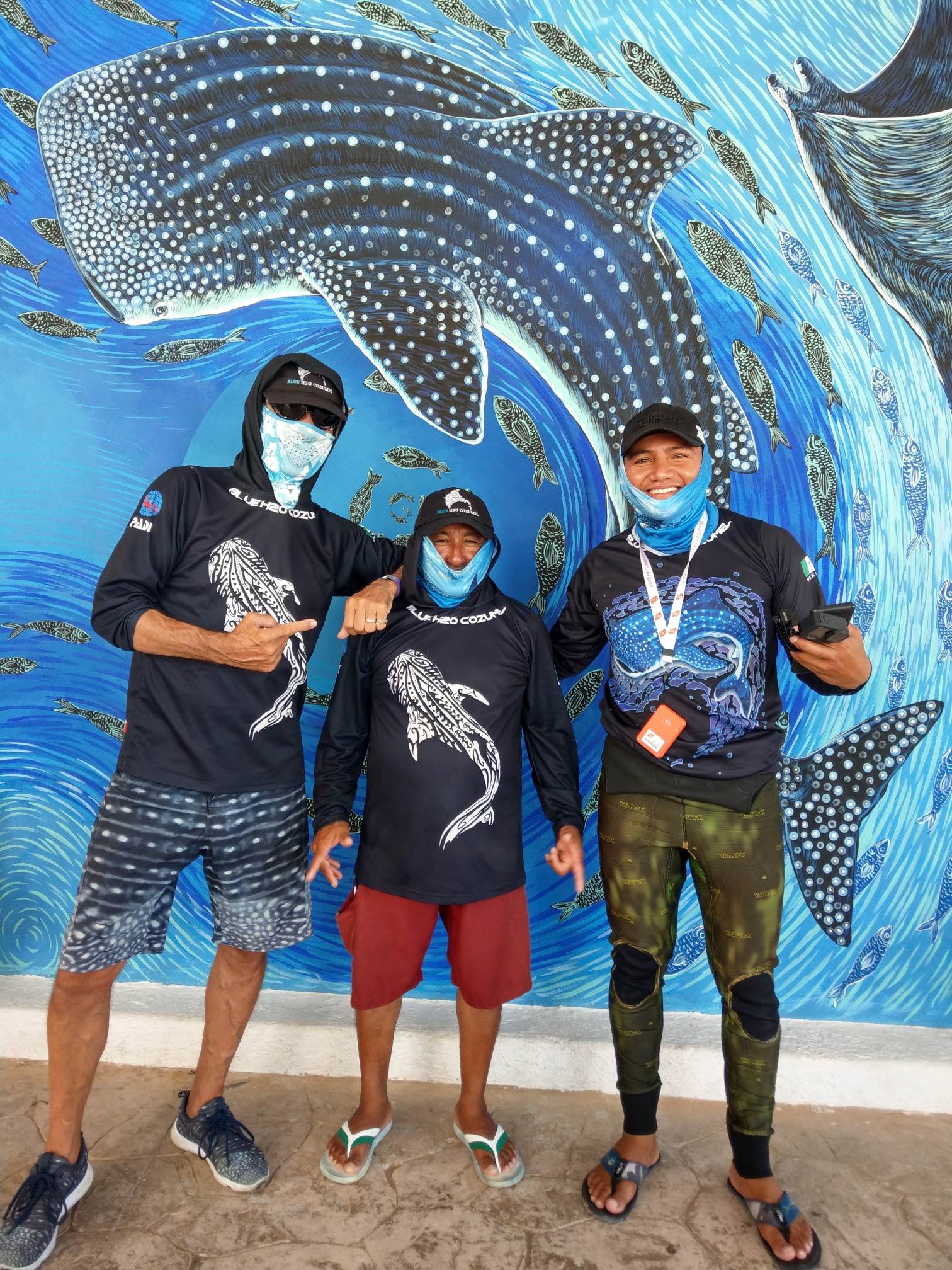 Whale Sharks filter feed, and can’t bite or chew, but they can filter about 6,000 liters of water per hour through their gills. They eat micro sized food such as fish eggs, plankton, krill and tiny fish which are sucked through their gill rakers.
Whale Sharks filter feed, and can’t bite or chew, but they can filter about 6,000 liters of water per hour through their gills. They eat micro sized food such as fish eggs, plankton, krill and tiny fish which are sucked through their gill rakers.
Their throat actually is like a funnel and tapers down to about the size of a quarter so impossible to swallow a person, and it’s possible to see them “cough” out larger objects. Their preferred method of feeding is to either just swim with their mouths wide open; filting out the food. Sometimes Whale Sharks do what is called “ram feeding,” which is they will find an area with lots of food and just be stationary.
Whale Sharks will also assume a vertical position, called botella” (bottle position) by the local guides.
They can live to be up to 150 years old, although only 10% of them make it to adulthood
Their average speed is 3mph although they can migrate vast distances
Where to See Whale Sharks
In the State of Quintana Roo both Holbox and Isla Mujeres are fortunate enough to be on the migration route. That means this can be done as a day trip from Cozumel (or Playa del Carmen or Cancun).
No tours allowed on 30th of each month.
Many operators offer transportation from Cozumel to Cancun where they board boats to see whale sharks.
From Cancun it’s about an hour and a half boat trip, where one can often see turtles, dolphins or other marine life in route, or 26 miles from Isla Mujeres by boat. It’s not uncommon to see giant mantas with the Whale Sharks as they feed on same food.
Tips for Choosing a Whale Shark Operator
Choose a tour operator – NOT a tour reseller make sure that who you’re speaking with will actually be accompanying you and not simply passing along the sale for a commission. Not only is it good business but you’ll have better customer service & immediate resolution in case of a problem. It is always better to book with organizations that run this tour themselves, rather than the resellers. The majority of the people or companies that sell the tour (excursion desks in hotels, street stands, dive shops) do not carry out this tour themselves. They sell the tour with high commissions, in some cases they’ll more than double the price, while paying very little to the tour operators
- Guaranteed sighting – Reputable companies stipulate if you do not see a whale shark, they will allow you to join another tour for free. (some restrictions apply)
- Ethical practices – Natural interaction with the whale sharks is very important. Whale sharks should not be attracted with food, nor should they feel scared or crowded. Some tour operators have less than ethical practices when swimming with whale sharks, or even break regulations. Ask in social media groups – like Cozumel 4 You – or read reviews online
- Season –There is no point visiting out of season, there will not be any whale shark tours. June, July, and August are the peak season here.
- Location – Interaction with the whale sharks is something that can be done in multiple locations, you can travel long distances – and stay over night, or take a day trip and see interesting attractions other than the whale sharks en route
- Cost – Note that this is last. While the experience needs to be affordable, ethical treatment, certified guides, commitment to marine preservation are key.
Additional Whaleshark Tour Facts
Space is limited. Remember only 80,000 people get to experience this every year, and there’s only 10 people per boat. Season is limited to JMid May – Mid September – Book well in Advance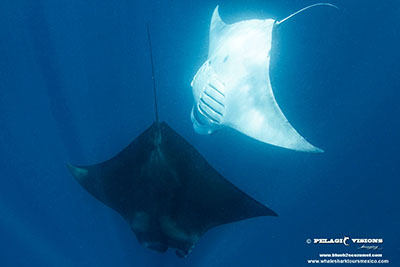
Due to the nature of these tours, they’re not very accessible to those with physical challenges or sea sicknesses
It’s important to be respectful of these gentle giants, not get into their path, make sudden movements, or startle them
Avoid sunscreen, since they’re filter feeding and don’t like the taste of sunscreen. Wear a rash guard or other protective clothing
Life jackets are required when in the water regardless of your experience level
Temporada 2023 del tiburón ballena: consejos para tener una mejor experiencia
Quintana Roo tiene la fortuna de encontrarse ubicado en la ruta del tiburón ballena (Rhincodon typus). Si bien Cozumel no forma parte de la ruta migratoria, desde mediados de mayo hasta finales de septiembre (los permisos del gobierno a los operadores de excursiones se expiden del 15 de mayo al 17 de septiembre), junio a agosto el periodo de mayor auge.
La experiencia para ver el tiburón ballena se realiza sólo con esnórquel (con la estricta prohibición de no tocar), y la práctica está altamente regulada. Es necesario que las embarcaciones cuenten con permisos, guías certificados y los funcionarios de la CONANP están verificando los documentos.
Esta excursión no es adecuada para personas que padecen de problemas cardiacos, problemas respiratorios, mujeres embarazadas, menores de 5 años o personas que no saben nadar (a menos que sólo deseen observar desde la embarcación).
Para poder participar en la experiencia con los tiburones, éstos son los requisitos:
- Sólo se permiten 2 participantes en el agua a la vez (sistema de apoyo entre compañeros).

- Un guía certificado estará en el agua con los participantes.
- La regla más importante: Está estrictamente prohibido tocar a los tiburones ballena y cualquier otro animal marino; se debe mantener una distancia de 3 metros (10 pies).
- Es obligatorio el uso de chalecos salvavidas tanto en la embarcación como en el agua. De nuevo permiten la opción del uso de trajes de neopreno si es que usted cuenta con alguno. Esta opción puede cambiar en cualquier momento.
- No se permite bucear. Sólo se permite la práctica de esnórquel.
- Puede usar su propia cámara sin problema. Está prohibido el uso de brazos extensibles de cámara y el uso de flash.
- En México no se alimenta a los tiburones ballena, y es ilegal arrojar cualquier tipo de comida o material al mar.
- NO está permitido el uso de protectores solares (incluso los “biodegradables”). Debe aplicarse el protector solar por la mañana en su hotel; de preferencia que sea un producto seguro/ecológico. Estos productos pueden interferir con la alimentación del tiburón ballena pues al deslavare flotan en la superficie donde se alimentan los tiburones. Es mejor protegerse con ropa protectora del sol, como camisetas de protección solar, camisas de manga larga, sombreros, gorros.
Estas normas han sido creadas por la Reserva del Tiburón Ballena en Áreas Nacionales Protegidas (ANP).
Datos sobre el tiburón ballena:
El tiburón ballena es miembro de la familia de los tiburones alfombra y, al igual que los tiburones nodriza, son considerados peces; de hecho, se distinguen por ser los mamíferos vertebrados más grandes del mundo.
Si bien los tiburones ballena no viajan en manadas (como lo hacen las ballenas), durante el verano se agrupan en sitios ricos en nu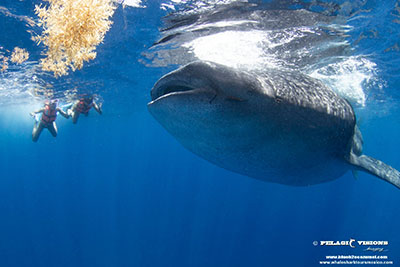 trientes como Isla Contoy. De hecho, la cifra de tiburones ballena en esa área está considerada como una de las mayores en el mundo. Por ejemplo, en 2013 más de 400 tiburones ballena visitaron el área. La mayoría de los tiburones ballena que se agrupan en verano son machos juveniles cuyo tamaño promedio es de 20 a 32 pies (6 a 9 metros). Por lo general, las hembras son más grandes, pero no abundan tanto en la zona.
trientes como Isla Contoy. De hecho, la cifra de tiburones ballena en esa área está considerada como una de las mayores en el mundo. Por ejemplo, en 2013 más de 400 tiburones ballena visitaron el área. La mayoría de los tiburones ballena que se agrupan en verano son machos juveniles cuyo tamaño promedio es de 20 a 32 pies (6 a 9 metros). Por lo general, las hembras son más grandes, pero no abundan tanto en la zona.
Los tiburones ballena se alimentan por filtración y no pueden morder ni masticar, pero pueden filtrar alrededor de 6,000 litros de agua por hora a través de sus branquias. Se alimentan de peces muy pequeños y, sobre todo, de plancton que succionan a través de las branquias.
Su garganta es como un embudo que se estrecha hasta llegar al tamaño de una moneda por lo que es imposible que se trague a una persona; pero sí es posible verlos “toser” objetos gran tamaño. Su método preferido para alimentarse es nadar con la boca abierta mientras filtran la comida. En ocasiones los tiburones ballena hacen lo que se conoce como “alimentación por embestida”, esto es, encontrarán un área con mucho alimento y permanecerán quietos.
Los tiburones ballena también adoptan una posición vertical que los guías locales llaman de “botella”.
Pueden vivir hasta 150 años, aunque sólo 10% llega a la edad adulta.
A pesar de que sy velocidad promedio es de 3 mph (4.82 km/hr), pueden migrar grandes distancias.
Dónde ver tiburones ballena
En el Estado de Quintana Roo tanto Holbox como Isla Mujeres tienen la fortuna de encontrarse en la ruta migratoria. Esto significa que se puede hacer la excursión de un día desde Cozumel (o Playa del Carmen o Cancún).
No se permiten excursiones los días 30 de cada mes.
Muchos operadores de servicio ofrecen transporte desde Cozumel a Cancún donde abordan las embarcaciones para ver los tiburones ballena.
El viaje en barco desde Cancún es de aproximadamente hora y media. Con frecuencia en el trayecto se pueden observar tortugas, delfines u otra vida marina; y desde Isla Mujeres son 26 millas (41.8 kms). No es extraño ver mantas gigantes con los tiburones ballena pues consumen el mismo alimento.
Sugerencias para elegir un operador de excursiones para ver tiburones ballena
- Elija un operador de excursiones, NO a un revendedor. Cerciórese de que la persona con quien usted habla le acompañará y no sólo se limitará a pasar la venta a otro para obtener una comisión. No sólo es una buena decisión, sino que también tendrá un mejor servicio como cliente
 y, en caso de algún problema, obtendrá una solución inmediata. Siempre es mejor reservar con empresas que realizan las excursiones ellas mismas en lugar de hacerlo a través de revendedores. La mayoría de las personas o empresas que venden la excursión (escritorios de excursiones en los hoteles, quiscos en la calle, tiendas de buceo) no hacen está excursión ellos mismos. Ellos venden la excursión con elevadas comisiones, en algunas ocasiones duplican el precio, en tanto que le pagan poco a los operadores de la excusión.
y, en caso de algún problema, obtendrá una solución inmediata. Siempre es mejor reservar con empresas que realizan las excursiones ellas mismas en lugar de hacerlo a través de revendedores. La mayoría de las personas o empresas que venden la excursión (escritorios de excursiones en los hoteles, quiscos en la calle, tiendas de buceo) no hacen está excursión ellos mismos. Ellos venden la excursión con elevadas comisiones, en algunas ocasiones duplican el precio, en tanto que le pagan poco a los operadores de la excusión.
- Paseo garantizado – Las empresas de más reputación estipulan que si no ve un tiburón ballena, le permitirán unirse a otra excursión de manera gratuita (aplican algunas restricciones).
- Prácticas éticas – La interacción natural con los tiburones ballena es muy importante. No se les debe atraer con comida, así como tampoco deben sentirse asustados o sentirse rodeados por una multitud. Las prácticas de algunos operadores de excursiones son muy poco éticas al nadar con los tiburones ballena o incluso incumplen las normas. Pregunte en grupos de redes sociales, como Cozumel 4 You, o lea las reseñas en línea.
- Temporada – No tiene sentido visitar el sitio fuera de temporada pues no hay excursiones para ver tiburones ballena. La temporada alta es junio, julio y agosto.
- Ubicación – La interacción con los tiburones ballena es algo que puede hacerse en diversos lugares. Puede viajar largas distancias y pernoctar, o hacer un viaje de un día y en el trayecto ver otras atracciones interesantes además de los tiburones ballena.
- Costo – Tome nota que hemos puesto esto al final. Si bien la experiencia debe ser accesible, son fundamentales el trato ético, los guías certificados y tener el compromiso de proteger la vida marina.
Datos adicionales:
Los espacios son limitados. Recuerde que cada año sólo 80,000 personas tienen la oportunidad de vivir esta experiencia y que únicamente se admiten 10 personas por embarcación. La temporada se limita a mediados de mayo y mediados de septiembre. Reserve con mucho tiempo de antelación.
Debido a la naturaleza de este tipo de excursiones, no son muy adecuadas para personas con problemas físicos o mareos.
Es importante respetar a estos gentiles gigantes, no interponerse en su camino, no hacer movimientos bruscos ni asustarlos.
Evite usar bloqueador solar pues los tiburones ballena se alimentan por filtración y no les gusta el sabor del bloqueador. Lleve una camiseta con protección solar u otro tipo de ropa protectora.
Sin importar su nivel de experiencia, el uso de chaleco salvavidas es obligatorio mientras está en el agua.
______________________________
Una ex yanqui de Connecticut quien llama hogar a Cozumel desde hace más de 15 años. Laura escapó al Caribe hace años, desplazándose de una isla a otra dando clases de BUCEO. Se dedicó a perder el tiempo en Jamaica y finalmente se detuvo en Cozumel para pasar unas vacaciones de 2 semanas que aún no terminan. Convenciendo a sus padres que pagaran una elegante universidad privada, obtuvo su título en Periodismo y Laura crea semanalmente Cozumel 4You, medios sociales y artículos promocionales sobre la Isla y también es moderadora en el grupo Cozumel 4 You en Facebook que actualmente cuenta con 25,000 miembros. Fabián, s umuy tolerante marido, desde hace mucho tiempo se resignó a no tener vida privada, pues se ha visto implicado en los diversos proyectos y planes que urde Laura. Son orgullosos padres de diversos perros y gatos rescatados. Mientras contempla su paso a través de la vida en el Caribe mexicano,Laura continúa siendo la pesadilla en la existencia de su muy tradicional suegra mexicana.
- Humane Society Cozumel Pet Week - March 28, 2025
- Cozumel Property Tax & Garbage Taxes - March 28, 2025
- Cozumel 4 You News March2025 - March 28, 2025
An ex-Connecticut Yankee who has called Cozumel home for over 18 years, Laura ran away to the Caribbean years ago, bumped around the islands teaching SCUBA diving, lost some time in Jamaica, and finally stopped in Cozumel for a 2 week vacation that hasn’t ended yet. With a degree in Journalism from a fancy private college she convinced her parents to pay for, Laura writes, edits, and creates the weekly Cozumel 4 You news, social media, and promotional articles about the island, as well as moderates the Cozumel 4 You Facebook group, which currently has over 25,000 members. Her long suffering husband, Fabian, has long since resigned himself to having zero private life, as he’s been involved in her various schemes and plots since his arrival. Proud parents to a variety of rescue dogs and cats, Laura continues to be the bane of her traditional Mexican mother-in-law’s existence, as she muses her way through life in the Mexican Caribbean. ______________________________ Una ex yanqui de Connecticut quien llama hogar a Cozumel desde hace más de 15 años. Laura escapó al Caribe hace años, desplazándose de una isla a otra dando clases de BUCEO. Se dedicó a perder el tiempo en Jamaica y finalmente se detuvo en Cozumel para pasar unas vacaciones de 2 semanas que aún no terminan. Convenciendo a sus padres que pagaran una elegante universidad privada, obtuvo su título en Periodismo y Laura crea semanalmente Cozumel 4You, medios sociales y artículos promocionales sobre la Isla y también es moderadora en el grupo Cozumel 4 You en Facebook que actualmente cuenta con 25,000 miembros. Fabián, s umuy tolerante marido, desde hace mucho tiempo se resignó a no tener vida privada, pues se ha visto implicado en los diversos proyectos y planes que urde Laura. Son orgullosos padres de diversos perros y gatos rescatados. Mientras contempla su paso a través de la vida en el Caribe mexicano, Laura continúa siendo la pesadilla en la existencia de su muy tradicional suegra mexicana.
Reef Care Parrotfish Slaughter Cozumel
Reef Care Parrotfish Slaughter Cozumel “Caring for our reefs is everyone’s responsibility,”...
Cozumel Flamingo
Cozumel Flamingo Flamingos Finally Return to Cozumel Punta Sur Representatives...
Cozumel Lifeguards Rescue Rip Current
Cozumel Lifeguards Rescue Rip Current Cozumel’s Lifeguards Rescue Swimmer from Strong Rip...
Cozumel Bees Protecting Education
Cozumel Bees Protecting Education Bee Friendly Cozumel: Protecting Bees and Educating the...


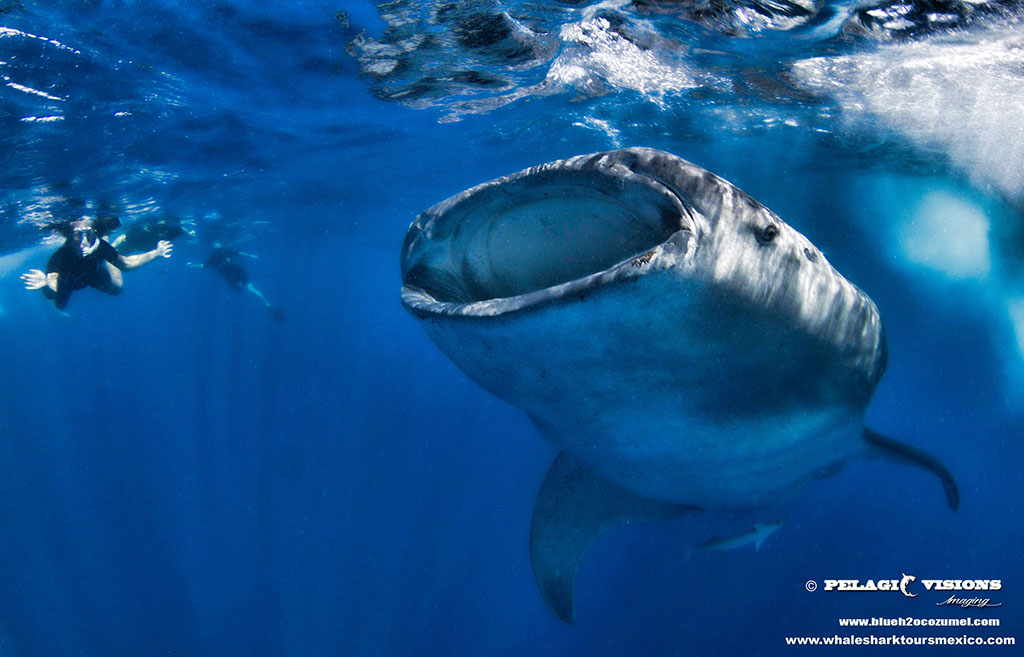
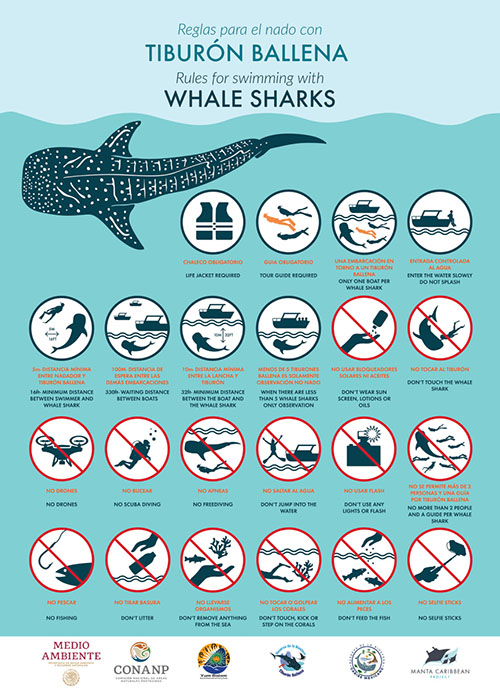
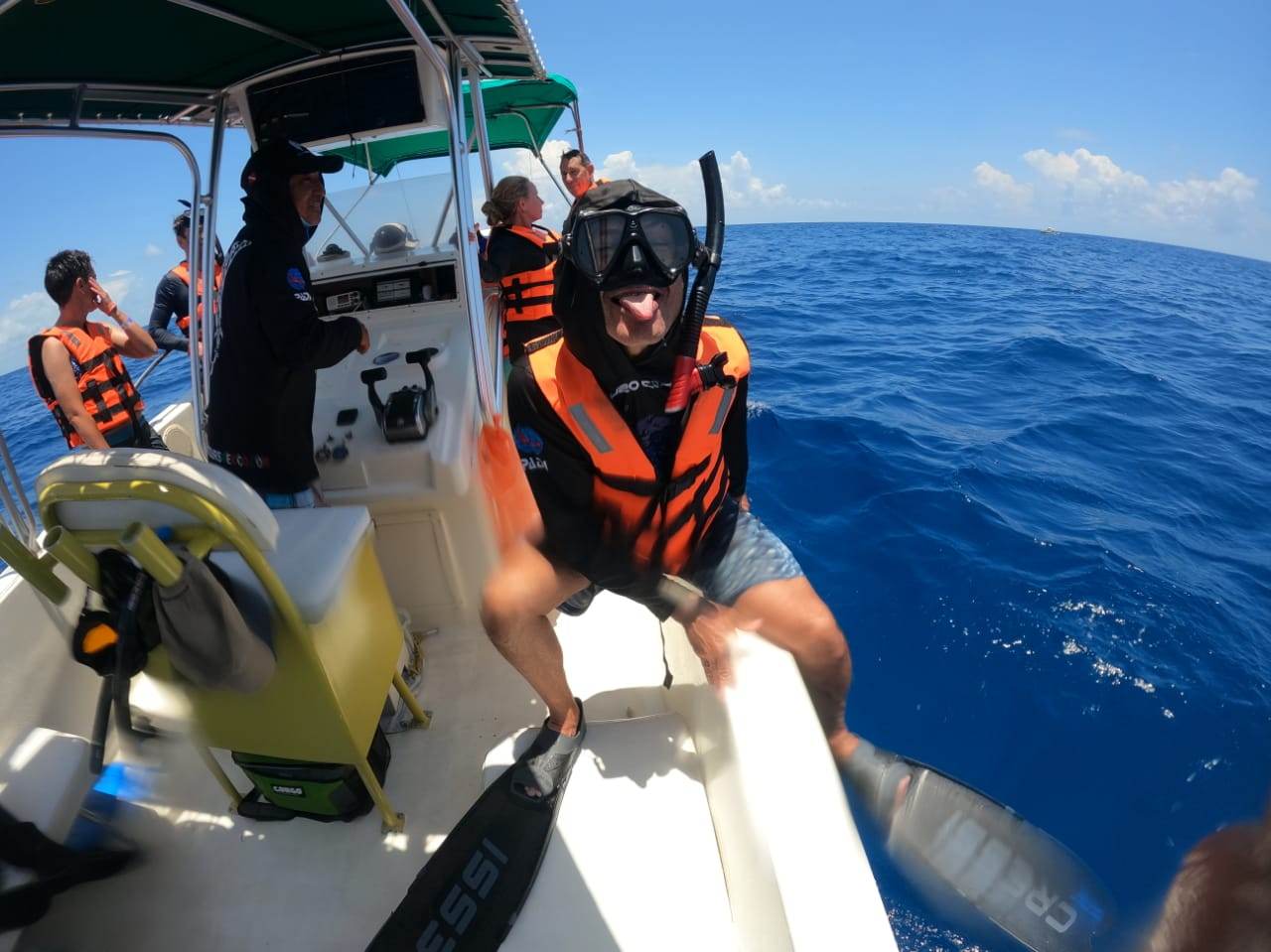
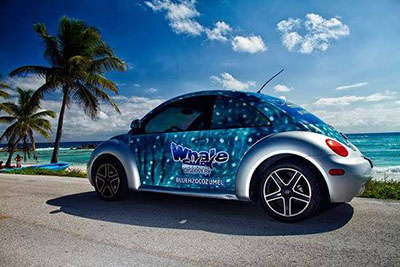
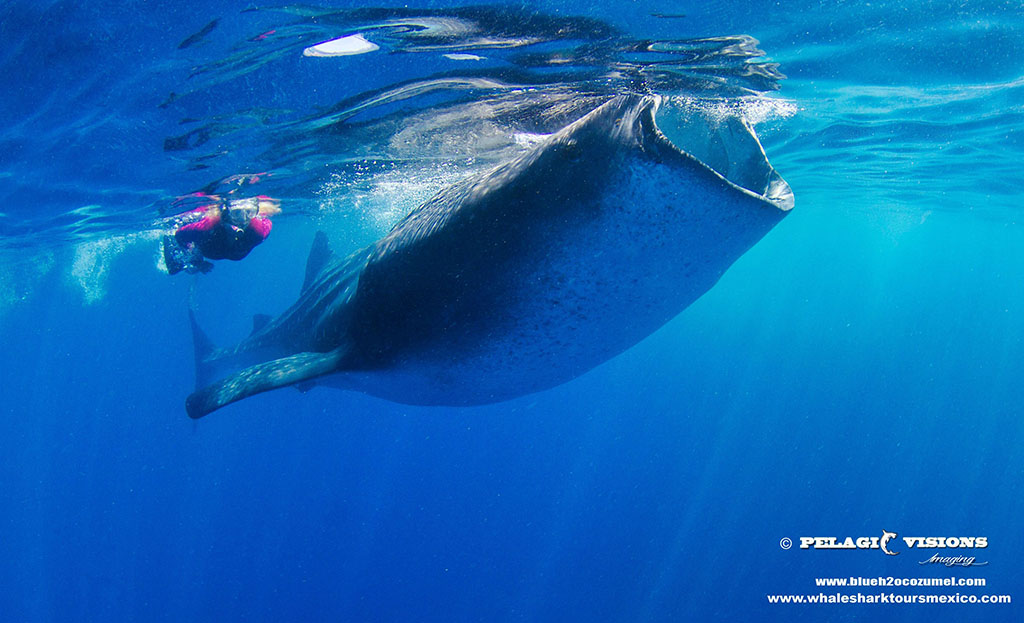
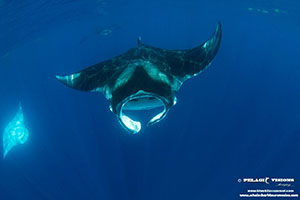
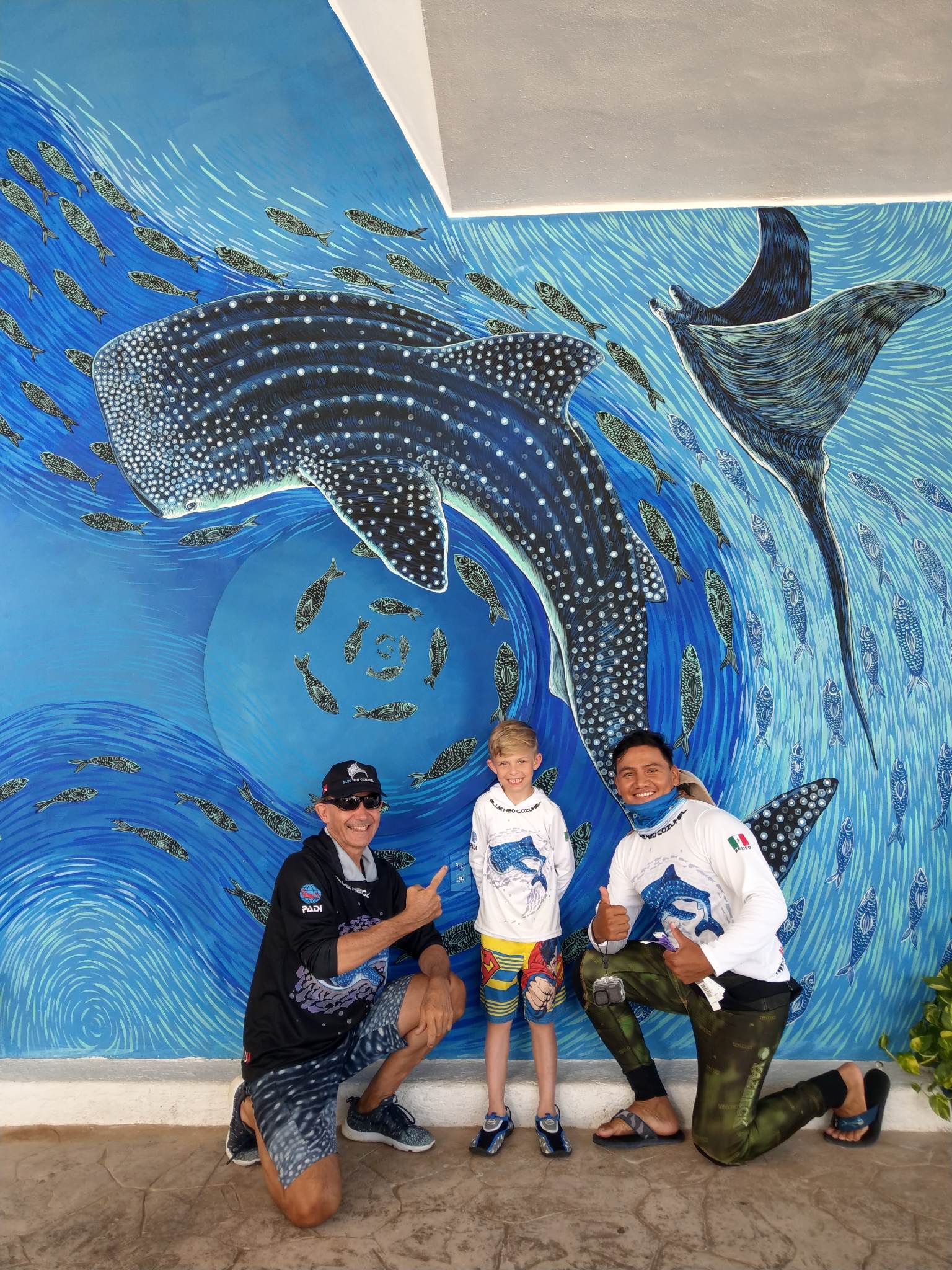
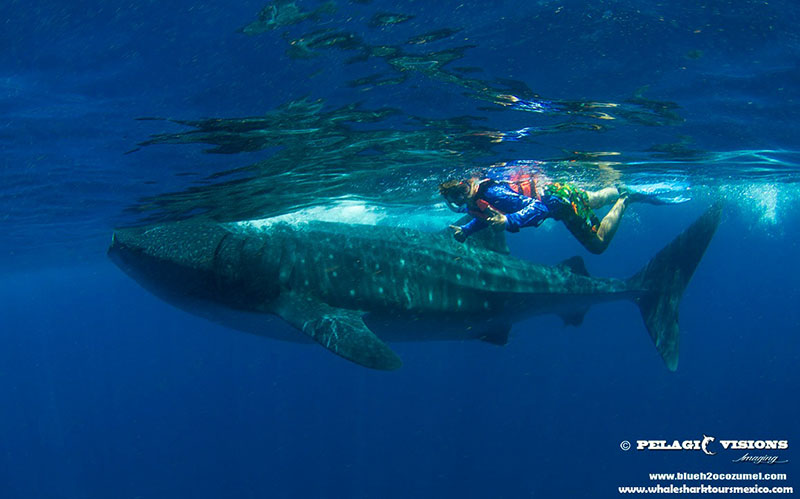





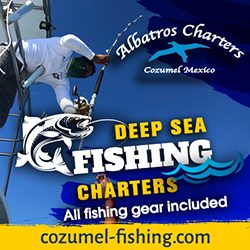


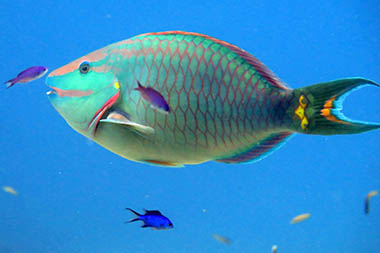
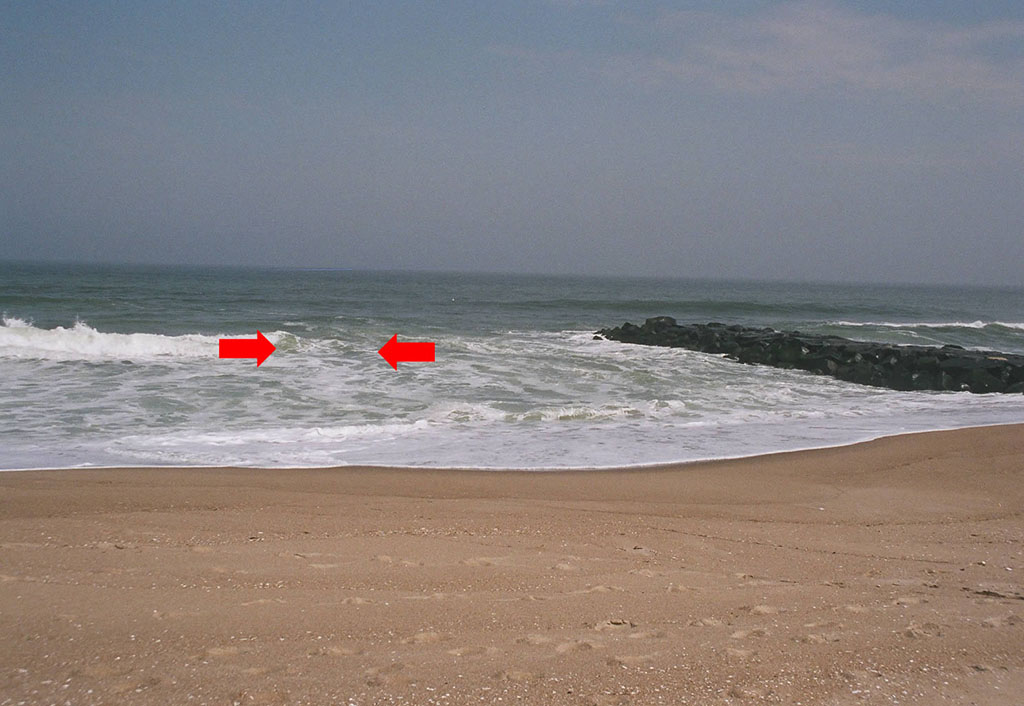








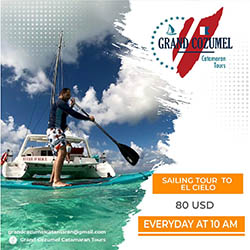
Leave a comment